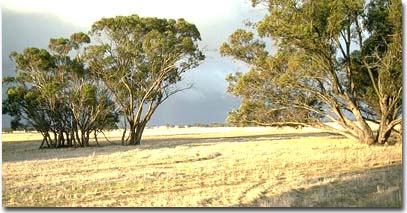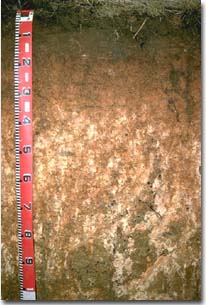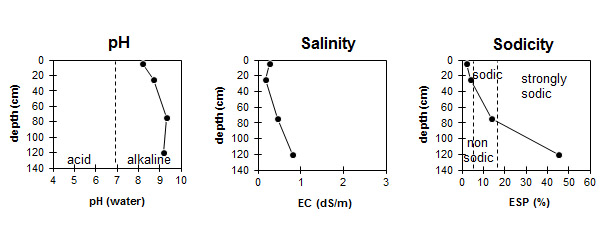LS11
Location: Propodollah
Australian Soil Classification: Epicalcareous-Endohypersodic, Epipedal, Red VERTOSOL
Northcote Factual Key: Ug 5.3
Great Soil Group: red clay
General Landscape Description: Gently undulating plain. Red and grey clay soils occur in association, the grey clays tending to be located in the lower lying areas.
Native Vegetation: Mallee species.
 LS11 Landscape |
Soil Profile Morphology:
Surface Soil
| A1 | 0-10 cm | Very dark greyish brown (10YR3/2); light medium clay; moderate medium blocky, parting to fine blocky structure; weak consistence moist; pH 8.2: |  LS11 Profile |
| Subsoil | |||
| B21 | 10-40 cm | Yellowish red (5YR4/8); heavy clay (with surface horizon infill); strong medium prismatic, parting to strong medium blocky structure; firm consistence dry; contains many (20-50 %) ironstone nodules; pH 8.7: | |
| B22k | 40-110 cm | Reddish brown (2.5YR5/6); light medium clay; structure similar to above horizon; very firm consistence dry; contains many (20-50 %) soft and hard carbonate nodules and some ironstone in patches; pH 9.3: | |
| B23 | 110+ cm | Yellowish red (5YR5/6): heavy clay; strong consistence dry; pH 9.2. | |
Key Soil Features:
- High clay content throughout soil profile.
- Contains significant amounts of soft and hard carbonate below 40 cm depth.
pH | Salinity | |||
Surface (A1 horizon) | Moderately Alkaline | Very Low | Non-Sodic | Slaking, No Dispersion1 |
Subsoil (B21 horizon) | Strongly Alkaline | Very Low | Non-Sodic | Slaking, No Dispersion |
Deeper Subsoil (at 1 metre) | Very Strongly Alkaline | Low-Medium | Strongly Sodic | Strong |

| The surface soil is moderatey alkaline. The subsoil is strongly alkaline becoming very strongly alkaline at depth. | The salinity rating is very low in the surface and upper subsoil becoming moderate with depth. | The surface and upper subsoil is non-sodic. The subsoil is strongly sodic. |
Chemical and Physical Analysis:
Horizon | Horizon Depth (cm) | pH (water) | pH (CaCl2) | EC dS/m | Exchangeable Cations | |||
Ca | Mg | K | Na | |||||
meq/100g | ||||||||
A1 | 0-10 | 8.2 | 7.6 | 0.26 | 17.5 | 3.1 | 2.9 | 0.5 |
B21 | 10-40 | 8.7 | 7.9 | 0.17 | 18.8 | 6.4 | 1.1 | 1 |
B22k | 40-110 | 9.3 | 8.3 | 0.46 | 10.1 | 10 | 0.7 | 3.3 |
B23 | 110+ | 9.2 | 8.6 | 0.81 | 2.4 | 12.3 | 1.1 | 12.5 |
Horizon | Horizon Depth (cm) | Total Nitrogen % | Oxidisable Organic Carbon % | Field Capacity pF2.5 | Wilting Point pF4.2 |
A1 | 0-10 | 0.22 | 2.4 | 27.1 | 16.7 |
B21 | 10-40 | 33.7 | 18.5 | ||
B22k | 40-110 | ||||
B23 | 110+ |
Management Considerations:
Surface (A) Horizon
- The surface horizon does not disperse but slakes upon rapid wetting. Maintaining adequate surface cover and organic matter levels will reduce slaking.
- The inherent fertility of the surface soil (based on the sum of the exchangeable basic cations) is high.
- Tillage or excessive trafficking of such clay soils should be avoided if the soil is moist to wet (ie. wetter than the plastic limit). Tillage or excessive trafficking when the soil is in this condition can result in structural damage (eg. compaction, smearing) occurring. Ideally, tillage should take place when the soil is drier than the plastic limit (at least the depth of tillage).
- The upper subsoil will present few restrictions to root and water movement (being non-sodic, having a reasonably high Ca:Mg ratio and being non-dispersive). The deeper subsoil below 40 cm becomes strongly sodic and dispersive which will restrict root and water movement at depth.
- The level of soluble salts increases with depth down the profile but may only restrict the growth of deeper-rooted salt sensitive species.
- The subsoil is strongly to very strongly alkaline. This indicates that certain nutrients (eg. iron, manganese, copper and zinc) may be poorly available to plants. Plant tissue analysis can be used to confirm nutrient deficiencies.
- Nitrogen added.
- Rotations involve fallow/wheat/legume(beans, peas)/barley/legume.
- Canola also grown.


